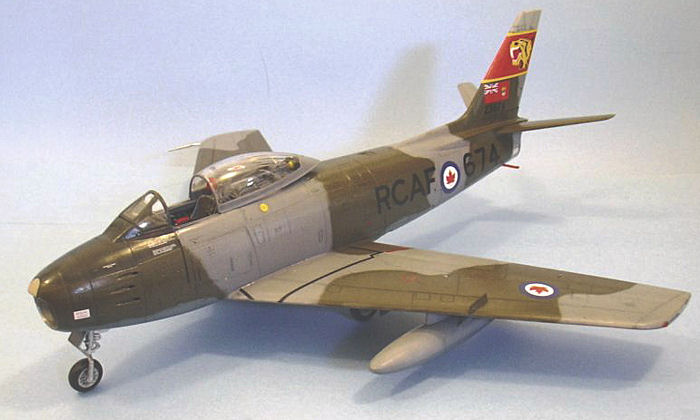
Kinetic 1/32 F-86F-30 Sabre
| KIT: | Kinetic 1/32 F-86F-30 Sabre |
| KIT #: | K3201 |
| PRICE: | $42.95 MSRP |
| DECALS: | two options |
| REVIEWER: | Tom Cleaver |
| NOTES: | Leading Edge decals and AMS resin cockpit |

| HISTORY |
When the North American Sabre flew in 1947, it attracted attention throughout the western aviation industry. In 1948, the Royal Canadian Air Force began serious planning for equipment of their fighter squadrons. It was obvious that the best fighter available was the Sabre, and during that year the Canadian government made a decision to equip the RCAF with the Sabre. A license agreement was quickly reached with North American and Canadair became the manufacturer of the Canadian Sabre, known as the CL-13. A total of 1,815 CL-13 Sabres were built by Canadair between 1950-58.
The initial production batch was for ten, to verify the tools, which led to the
production of the one and only Sabre Mk. I, a direct copy of the F-86A. By this
time, North American was produc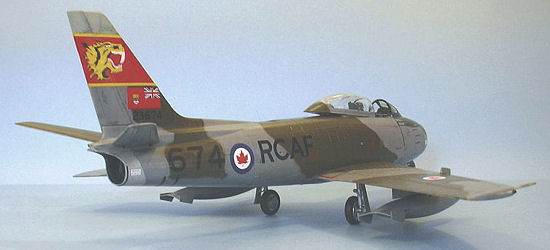 ing the improved F-86E with the all-flying tail
that made the Sabre easily transonic in a dive. The outbreak of the Korean War
changed the initial production contract from ten to 100. In 1951, the need of
the USAF for the Sabre was so great that Canadair produced 100 F-86Es as the
F-86E(M), which were sent to Korea to make up combat attrition.
ing the improved F-86E with the all-flying tail
that made the Sabre easily transonic in a dive. The outbreak of the Korean War
changed the initial production contract from ten to 100. In 1951, the need of
the USAF for the Sabre was so great that Canadair produced 100 F-86Es as the
F-86E(M), which were sent to Korea to make up combat attrition.
The Sabre Mk. 2 introduced powered controls and the all-flying tail, while the only Sabre Mk. 3 was the first Canadian Sabre to use the magnificent Orenda 3 turbojet with 6,000 lb thrust, which was a vast improvement on the J-47GE-13 used for the Mk. 2 and on USAF Sabres. The Sabre Mk. 4 retained the GE engine and was produced for the RAF as that service’s first swept-wing fighter. The Sabre Mk. 5 used the Orenda 10 with 6,500 lbs thrust.
The best Sabre ever produced by anyone was the Sabre Mk. 6, which was to the
rest of the Sabres as the MiG-17 was to the MiG-15 in terms of performance.
Powered by the Orenda 14 with 7,275 lbs of thrust - a 150% increase over the
power of US Sabres - the Sabre Mk. 6 outperformed every fighter in its class. It
had the best climb performance and altitude of any Sabre; had the
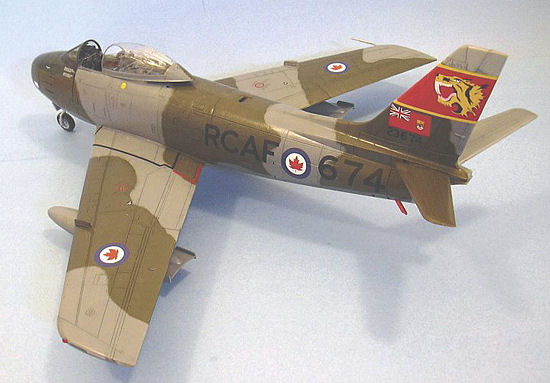 Sabre 6 been
the opponent of the MiG-15 over the Yalu in Korea, it would have been the
Soviets who would have been looking up to find Sabres diving on them.
Sabre 6 been
the opponent of the MiG-15 over the Yalu in Korea, it would have been the
Soviets who would have been looking up to find Sabres diving on them.
The first 220 Mk. 6 Sabres had the 6-3 wing of the F-86F series. The slats were brought back from that point for the rest of the 655 Mk. 6s produced, which improved low-speed performance without losing high speed performance.
The first Sabre Mk.6 was completed November 2, 1954. 390 Mk 6s equipped the four RCAF Sabre wings serving in France and West German with NATO, where the Sabre Mk. 6 was considered the best dogfighter of any fighter serving with a NATO Air Force. 225 Sabre Mk. 6s were supplied to the new German Luftwaffe, beginning in 1955, where they served until replaced by the F-104G in 1964.
The Sabre Mk. 6 lived up to its potential in the Indo-Pakistani War of 1971, where the 90 Sabre Mk. 6s sold by Germany to Iran and passed on to Pakistan were the main day fighter of the Pakistani Air Force.
| THE KIT |
The
Sabre was first done in 1/32 scale by Hasegawa in 1972, and that has been the
only kit in the scale since until the advent of this new kit from Kinetic.
The Ha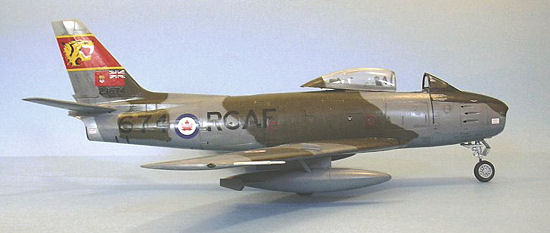 segawa kit is a
long-wing F-86F-40. There are accuracy issues with the size of the cockpit
and overall shape of the canopy.
segawa kit is a
long-wing F-86F-40. There are accuracy issues with the size of the cockpit
and overall shape of the canopy.
Much ado was made of the surface detail of this kit when the first pictures were made available on the internet. The good news is that the surface detail of this kit is actually quite accurate when compared to the two real F-86s out at Chino.
The decals provided are for McConnell’s second F-86 and for “Mike’s Bird.”
The kit provides a substantial metal weight, which will guarantee nose sitting even if you decide to include the engine - which will need a lot of work - in your finished model.
| CONSTRUCTION |
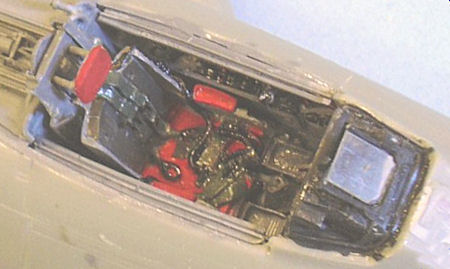 The
initial appearance of the kit is reminiscent of a 21st Century Toys kit - the
parts are large and a bit clunky, but they go together easily and present no fit
problems. I had to use Mr. Surfacer on all the seams and then rescribe the
light rivet detail that was lost with my pounce wheel. The end result when the
kit is assembled is very impressive.
The
initial appearance of the kit is reminiscent of a 21st Century Toys kit - the
parts are large and a bit clunky, but they go together easily and present no fit
problems. I had to use Mr. Surfacer on all the seams and then rescribe the
light rivet detail that was lost with my pounce wheel. The end result when the
kit is assembled is very impressive.
The most important thing I did with the kit was to use the resin detail parts created by Harold Offield of AMS Resin. The gun sight, instrument panel, cockpit sidewalls and control stick are all far superior to those provided in the kit. What is truly stupendous is the resin seat, which is the most detailed seat I have seen. When painted, it really does “look real.” I strongly recommend you get this complete set from him, since it vastly improves the final look of the model.
| COLORS & MARKINGS |
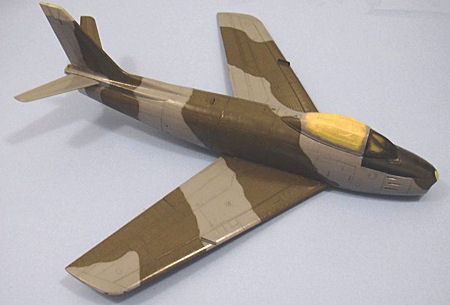 The
model was painted with Xtracrylix Dark Sea Grey, RAF Dark Green, and PRU Blue,
after I preshaded the model with flat black airbrushed on the panel lines. The
Leading Edge decal sheet provided profiles to show the camouflage pattern, which
was easy to follow. The scheme was done freehand, with a light bit of
post-shading of each color.
The
model was painted with Xtracrylix Dark Sea Grey, RAF Dark Green, and PRU Blue,
after I preshaded the model with flat black airbrushed on the panel lines. The
Leading Edge decal sheet provided profiles to show the camouflage pattern, which
was easy to follow. The scheme was done freehand, with a light bit of
post-shading of each color.
Decals:
I used the Leader Edge “First Wing Sabre Mk.6" sheet, which is all early-production Sabre Mk. 6s from the three squadrons of the First Wing, which all have the 6-3 “hard” wing which the kit provides. The decals include a complete stencil sheet. Everything went on easily and snuggled down under a coat of Micro-Sol. I finished off with two coats of Xtracrylix Satin Varnish, which gives a “scale” gloss finish to the model.
| FINAL CONSTRUCTION |
I particularly like the wheels on this kit, with the tires done in plastic, separate from the hubs. This allows pre-painting and results in a good-looking wheel, which is something many modelers have difficulty doing when they paint a single-part wheel. The landing gear went on without trouble, as did the drop tanks.
Photos of RCAF Sabres show they were well-maintained and free of dings, so I did no weathering.
| CONCLUSIONS |
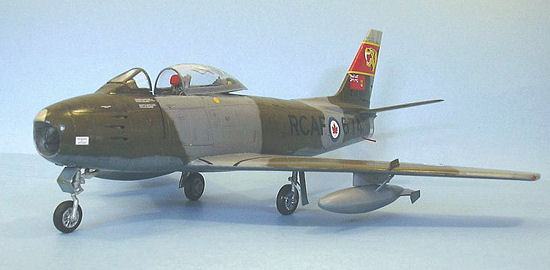 This Sabre kit from Kinetic fills the need for an updated and accurate model of
this famous fighter. The model looks remarkably accurate when completed. I
think the camouflaged Sabre looks even better than the silver Sabre. At an MSRP
of $39.95, the kit represents excellent value. It’s an easy model to build and
looks very impressive when completed. Highly recommended.
This Sabre kit from Kinetic fills the need for an updated and accurate model of
this famous fighter. The model looks remarkably accurate when completed. I
think the camouflaged Sabre looks even better than the silver Sabre. At an MSRP
of $39.95, the kit represents excellent value. It’s an easy model to build and
looks very impressive when completed. Highly recommended.
Review kit courtesy of my wallet.
March 2008
If you would like your product reviewed fairly and quickly, please contact me or see other details in the Note to Contributors.